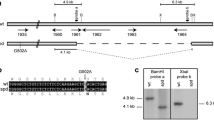Summary
Inheritable sporulation-deficient dikaryons were obtained through pairing compatible monokaryons. The morphological character of centralized stipes of sporulation-deficient fruit bodies was remarkable and enable them to be distinguished from sporulating ones. Light and electron microscopy showed neither spores nor sterigmata on the surface of most basidia. However, in rare cases, some basidia, always clustering in a number of a few to tens, had one abortive spore on each basidium. No mature spores were found. Genetic analysis of sporulation deficiency was carried out by test-crosses. Results suggest that sporulation-deficient mutant inP. florida is rather complex and might be controlled by two recessive genes. The recovery of four mating types in spores obtained from the dikaryotic fruit body used for test-crosses, and the presence of four nuclei on the apex of basidia of sporulation-deficient strain indicated that the process of meiosis had occurred in this sporulation-deficient mutant.
Résumé
Des dikaryons à sporulation déficiente héritable ont été obtenus en accouplant des monokaryons compatibles. Le caractère morphologique des tiges centralisées des corps fruitaux déficients en sporulation est remarquable et permet de les distinguer de ceux sporulants. La microscopie optique ou électronique ne montre mi spores ni stérigmates sur la surface de la plupart des basidia. Toutefois, dans quelques rares cas, quelques basidia, toujours agglutinés par groupe de quelques unités à quelques dizaines d'unités, ont une spore avortée sur chaque basidium. On ne trouve pas de spores mûres. L'analyse génétique de la déficience en sporulation a été réalisée par des tests de croisements. Les résultats suggèrent que la mutation de déficience en sporulation chezP. florida est plutôt complexe et pourrait bien être contrôlée par deux gènes récessifs. L'obtention de quatre types d'accouplement chez les spores obtenues du corps fruital dikaryotique utilisé pour les tests de croisements, et la présence de quatre noyaux dans l'apex des basidia de la souche déficiente en sporulation, suggère que le processus de méiose se passe bien chez le mutant déficient en sporulation.
Similar content being viewed by others
References
Bromberg, S. &Schwalb, M. N. 1977 Isolation and characterization of temperature sensitive sporulationless mutants of the basidiomyceteSchizophyllum commune.Canadian Journal of Genetic Cytology 19, 477–481.
Chang, S. T., Yu, M. L. &Lau, W. C. 1985 A sporeless strain inPleurotus florida.Mushroom Newsletter for the Tropics 5 (3), 19–21.
Chang, S. T. &Miles, P. G. 1989 The nutritional attributes and medicinal value of edible mushrooms. InEdible Mushrooms and Their Cultivation, pp. 27–38. Florida: CRC Press.
Chiu, S. W. &Chang, S. T. 1987Volvariella bombycina and its life history.Mushroom Journal for the Tropics 7, 1–12.
Dieleman-Van Zaayen, A. 1972 Electron microscopy of mycelium, fruitbodies and basidiospores of virus-diseased mushroom,Agaricus bisporus.Mushroom Science 3, 425–439.
Eger, P. G., Eden, G. &Wissing, E. 1976Pleurotus ostreatus-breeding potential of a new cultivated mushroom.Theoretical and Applied Genetics 47, 155–163.
Eger, G. 1977 Sporeless strain — A necessity in the production ofPleurotus ostreatus.Taiwan Mushroom 1(3), 79–82.
Eugenio, C. P. &Anderson, N. A. 1968 The genetics and cultivation ofPleurotus ostreatus.Mycologia 60, 627–634.
Lau, W. C., Dhillon, E. K. S. &Chang, S. T. 1985 Isolation and reversion of protoplasts ofPleurotus sajor-caju.MIRCEN Journal of Applied Microbiology and Biotechnology 1, 345–353.
Kaufert, F. H. 1935 The production of asexual spores byPleurotus corticatus.Mycologia 27, 333–341.
Miles, P. G. &Raper, J. R. 1956 Recovery of component strains from dikaryotic mycelia.Mycologia 48, 484–494.
Mounce, I. 1922 Homothallism and heterothallism in the genusCoprinus.Transactions of the British Mycological Society 7, 256–269.
Ohira, I. 1977Pleurotus ostreatus and its related species.Report of Tottori Mycological Institute (Japan) 15, 29–37.
Ohira, I. 1979 Sporulation-deficient mutant inPleurotus pulmonarius Fr.Transactions Mycological Society (Japan) 20, 107–114.
Olson, J. A. 1987Pleurotus spores as allergens.Mushroom Journal 172, 115–117.
Raper, J. R. 1960 Tetrapolarity inSchizophyllum fasciatum.Mycologia 52, 334–336.
Roxon, J. E. &Jong, S. C. 1977 Sexuality of an edible mushroom,Pleurotus sajor-caju.Mycologia 69, 203–205.
Sakula, A. 1974 Allergy to the spores ofPleurotus florida.Lancet i, 137.
Takemaru, T. &Kamada, T. 1972 Basidiocarp development inCoprinus macrorhizus 1. Induction of developmental variations.Botanical Magazine (Tokyo) 85, 51–57.
Toole, E. R. 1959 Decay after fire injury to southern bottomland hardwoods.U.S. Department of Agriculture Technical Bulletin, No. 1189.
Author information
Authors and Affiliations
Rights and permissions
About this article
Cite this article
Yu, M., Chang, S.T. Mutants ofPleurotus florida deficient in sporulation. World J Microbiol Biotechnol 5, 487–492 (1989). https://doi.org/10.1007/BF01741824
Received:
Accepted:
Issue Date:
DOI: https://doi.org/10.1007/BF01741824




